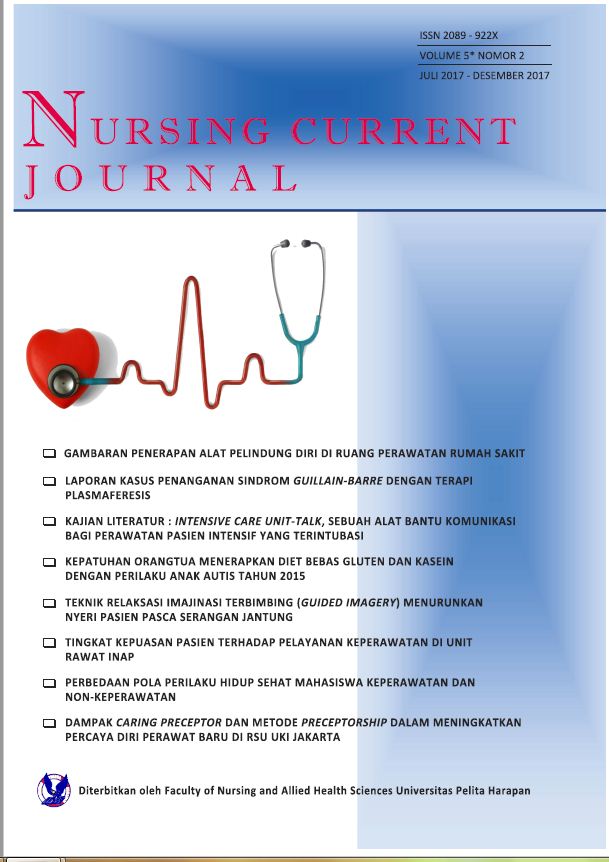DIFFERENCES IN HEALTHY BEHAVIOR PATTERNS OF NURSING AND NON-NURSING STUDENTS [PERBEDAAN POLA PERILAKU HIDUP SEHAT MAHASISWA KEPERAWATAN DAN NON-KEPERAWATAN]
DOI:
https://doi.org/10.19166/nc.v5i2.1713Λέξεις-κλειδιά:
Healthy Lifestyle, Nursing Students, Non-Nursing StudentsΠερίληψη
Nursing students as health profession members are educated to adequate knowledge and positive attitude toward healthy lifestyle. Nursing students are expected healthier lifestyle than the non-nursing students. Health lifestyle of nursing students will affect their lives in the future. However, no studies have found relationships between nursing students and non-nursing students using Health Promoting Lifestyle Profile II (HPLP-II) questionnaire in Indonesia. The purpose of this study is to identify similarities and differences between the nursing students and non-nursing students used a descriptive quantitative with comparative approach. Data were collected by using the Indonesian version of the HLPL II questionnaire. In the present study, HPLP-II questionnaire consist of a 22-item with a 4-point Likert in three theoretical dimensions. The respondents are 113 nursing students and 112 non-nursing students. The result reveals that the mean item score for total HPLP-II of nursing students (2,51 ± 0,38) is higher than the non-nursing students (2,32 ± 0,80). Nursing students’ score is higher than their overall HPLP and in the subcategories of health responsibility, physical activity and spiritual growth. The statistical analysis shows a significant difference between HPLP-II nursing students and HPLP-II non-nursing students (p = 0.024). Furthermore, further research is needed to find the factors cause differences of healthy lifestyle of nursing students and non-nursing students
BAHASA INDONESIA ABSTRAK Mahasiswa keperawatan sebagai anggota profesi kesehatan dididik agar memiliki pengetahuan dan sikap yang memadai terhadap perilaku hidup sehat. Mahasiswa keperawatan diharapkan memiliki perilaku hidup yang lebih sehat dibandingkan mahasiswa non-keperawatan. Perilaku hidup sehat mahasiswa keperawatan mempengaruhi kehidupan mereka di masa depan. Selain itu belum ada penelitian yang menemukan hubungan antara mahasiswa keperawatan dan non-keperawatan menggunakan kuesioner Health Promoting Lifestyle Profile II (HPLP-II) di Indonesia. Penelitian ini bertujuan mengidentifikasi persamaan dan perbedaan pola perilaku hidup sehat antara mahasiswa keperawatan dan non-keperawatan menggunakan deskriptif kuantitatif dengan pendekatan studi komporatif. Populasi adalah mahasiswa fakultas keperawatan dan mahasiswa fakultas desain Universitas X. Sampel menggunakan tehnik purposive sampling sebanyak 113 mahasiswa keperawatan dan 112 mahasiswa desain. Instrumen berupa kuesioner HPLP-II yang diadaptasi dalam bahasa Indonesia yang terdiri dari 22 item pertanyaan dalam skala Likert dengan tiga subskala. Hasil penelitian skor rata-rata total HPLP mahasiswa keperawatan (2,51 ± 0,38) lebih tinggi daripada mahasiswa non keperawatan (2,32 ± 0,80). Mahasiswa keperawatan mempunyai subskala perkembangan spiritual, tanggung jawab kesehatan dan aktivitas fisik lebih tinggi daripada mahasiswa non-keperawatan. Analisis statistik ditemukan ada perbedaan yang signifikan antara mahasiswa keperawatan dan non-keperawatan (p = 0.024). Penelitian selanjutnya perlu mengidentifikasi faktor-faktor penyebab perbedaan pola perilaku hidup sehat antara mahasiswa keperawatan dan non-keperawatan.
Αναφορές
Al-Kandari, F., & Vidal, V. L. (2007). Correlation of the health-promoting lifestyle, enrollment level, and academic performance of College of Nursing students in Kuwait, Nursing and Health Sciences, 9(2), 112-119. https://doi.org/10.1111/j.1442-2018.2007.00311.x
Al-Khawaldeh, O. (2014). Health promoting lifestyles of Jordanian university students, International Journal of Advanced Nursing Studies, 3(1),27-31. https://doi.org/10.14419/ijans.v3i1.1931
Can, G. et al. (2008). Comparison of the health-promoting lifestyles of nursing and nonnursing students in Istanbul, Turkey. Nursing and Health Sciences, 10(4), 273-280. https://doi.org/10.1111/j.1442-2018.2008.00405.x
Damayanti, M. R., & Karin, P. A. E. S (2016). Gambaran pola perilaku hidup sehat pada mahasiswa program studi ilmu keperawatan Fakultas Kedokteran Universitas Udayana. Coping: Community of Publishing in Nursing, 4(1), 28-35. https://ojs.unud.ac.id/index.php/coping/article/view/19910
Haddad, L., et al. (2004). A Comparison of Health Practices of Canadian and Jordanian Nursing Students. Public Health Nursing, 21(1), 85-90. https://doi.org/10.1111/j.1525-1446.2004.21112.x
Hong, J. F. (2007). Health-Promoting Lifestyles of Nursing Students in Mahidol University. Journal of Public Health and Development, 5(1), 27-40. https://ci.nii.ac.jp/naid/20000909019/
Jang, H. J. (2016). Comparative Study of Health Promoting Lifestyle Profiles and Subjective Happiness in Nursing and Non- Nursing Students. Advanced Science and Technology Letters, , 128, 78-82. https://doi.org/10.14257/astl.2016.128.16
Özçakar, N., et al. (2015). Healthy Living Behaviors of Medical and Nursing Students. International Journal of Caring Sciences, 8(3), 3-536. www.internationaljournalofcaringsciences.org
Saifudin. (2012) Hubungan antara stres dengan pola tidur dan siswa SMP pondok pesantren modern MBS di Bokoharjo, Prambanan, Sleman. Skripsi. STIKES Aisyiyah Yogyakarta. http://opac.say.ac.id/921/1/Naskah%20Publikasi%20Umar%20Saifudin.pdf
Λήψεις
Δημοσιευμένα
Πώς να δημιουργήσετε Αναφορές
Τεύχος
Ενότητα
Άδεια
Authors who publish with this journal agree to the following terms:
1) Authors retain copyright and grant the journal right of first publication with the work simultaneously licensed under a Creative Commons Attribution License (CC-BY-SA 4.0) that allows others to share the work with an acknowledgement of the work's authorship and initial publication in this journal.
2) Authors are able to enter into separate, additional contractual arrangements for the non-exclusive distribution of the journal's published version of the work (e.g., post it to an institutional repository or publish it in a book), with an acknowledgement of its initial publication in this journal.
3) Authors are permitted and encouraged to post their work online (e.g., in institutional repositories or on their website). The final published PDF should be used and bibliographic details that credit the publication in this journal should be included.

This work is licensed under a Creative Commons Attribution-ShareAlike 4.0 International License.






